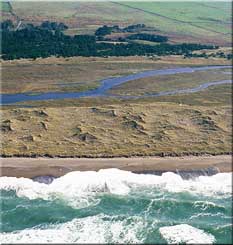

|
||
Water + Wind = WavesThe narrow strips where the land meets the sea - coastlines - are among the most dynamic environments on Earth. Relentless attack by waves gnaws away at even the hardest of rocky coasts, reshaping the shore with each passing wave. Even the most gentle waves change the shape of the shoreline each day in imperceptible ways. It takes lots of energy to make the waves crashing against Oregon's shoreline in the image at left. Where does this energy come from? The single most important wave-building energy source is wind. Wind-generated waves may originate thousands of kilometers out at sea. Out in the deep open ocean, waves usually start out small and choppy. If the wind is strong and lasts long enough, the wave pattern becomes more organized. Storm-driven waves often travel towards the distant shore as low, rounded swells. As swells approach the shallow coastline they begin to touch bottom. Water drags against the sea bottom, slowing its forward movement. While the wave slows, water piles up, building higher and higher waves as the bottom shallows.
|
||
| On to Building Beaches Return to Where Parks Meet the Sea index |
|
| |
| | |

